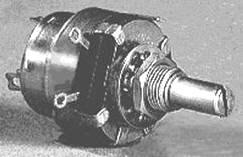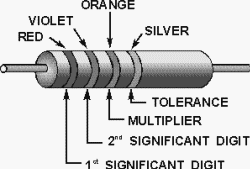[Go to TOC]
Module 1 - Introduction to Matter, Energy, and Direct Current
Pages i,
1-1,
1-11,
1-21,
1-31,
1-41,
1-51,
1-61,
2-1,
2-11,
2-21,
3-1,
3-11,
3-21,
3-31,
3-41,
3-51,
3-61,
3-71,
3-81,
3-91,
3-101,
3-111,
3-121, Appendix
I,
II,
III,
IV,
V,
Index
The POTENTIOMETER
and The RHEOSTAT are variable resistors and can be adjusted to any resistance value within their ohmic range.
The rheostat is usually used for relatively high current applications and has two connections; the potentiometer
has 3 connections and is a relatively high- resistance, low-current device.

Two examples potentiometers.

Example of a rheostat.
1-61
Table 1-1. - Standard Color Code for Resistors
|
COLOR |
SIGNIFICANT FIGURE |
DECIMAL MULTIPLIER |
TOLERANCE PERCENT |
RELIABILITY LEVEL PER 1,000 HRS. |
|
BLACK |
0 |
1 |
PERCENT |
1.0% |
|
BROWN |
1 |
10 |
1 |
.1% |
|
RED |
2 |
100 |
2 |
.01% |
|
ORANGE |
3 |
1,000 |
. |
001% |
|
YELLow |
4 |
10,000 |
- |
- |
|
GREEN |
5 |
100,000 |
- |
- |
|
BLUE |
6 |
1,000,000 |
- |
- |
|
VIOLET |
7 |
10,000,000 |
- |
- |
|
GRAY |
8 |
100,000,000 |
- |
- |
|
WHITE |
9 |
1,000,000,000 |
- |
- |
|
GOLD |
- |
.1 |
5 |
- |
|
SILVER |
- |
.01 |
10 |
- |
|
NO COLOR |
- |
- |
20 |
- |
The WATTAGE RATING of a Resistor is related to the resistor's physical size, that is,
the greater the surface area exposed to the air, the larger the rating.
The STANDARD COLOR Code
for resistors is used to determine the following:
1. Ohmic value
2. Tolerance
3. Reliability level (on some resistors)

1-62
Answers to Questions Q1 Through Q65.
A1. Anything that occupies space and has weight. Solids, liquids, gases.
A2. a substance
which cannot be reduced to a simpler substance by chemical means.
A3. a substance consisting two
or more elements.
A4. a compound is a chemical combination elements that cannot be separated by
physical means. a mixture is a physical combination elements and compounds that are not chemically combined.
A5. a chemical combination two or more atoms.
A6. Electrons-negative, protons-positive,
and neutrons-neutral.
A7. Kinetic energy.
A8. Invisible light photons (ultraviolet)
bombard the phosphor atom in the light tube. The phosphor atoms emit visible light photons.
A9.
The number electrons in the outer shell.
A10. An atom with more or less than its normal number
electrons.
A11. The number valence electrons.
A12. Through the accumulation
excess electrons.
A13. By friction.
A14. Negative.
A15. Like charges
repel, and unlike charges attract with a force directly proportional to the product their charges and inversely
proportional to the square the distance between them.
A16. The space between and around charged
bodies.
A17. Leaving positive, entering negative.
A18. Motors, generators,
speakers, computers, televisions, tape recorders, and many others.
A19. Those materials that are
attracted by magnets and have the ability to become magnetized.
A20. The relative ease with which
they are magnetized.
A21. a material that exhibits low reluctance and high permeability, such as
iron or soft steel.
A22. The ability a material to retain magnetism.
A23. They
are very similar; like charges repel, unlike charges attract, like poles repel - unlike poles attract.
A24. To the magnetic north pole.
A25. South pole at the right, north pole at the left.
1-63
A26. The domain theory is based upon the electron spin principle; Weber's theory uses the
concept tiny molecular magnets.
A27. To enable you to "see" the magnetic field.
A28.
No specific pattern, sawdust is a nonmagnetic material.
A29. An imaginary line used to illustrate
magnetic effects.
A30. Electrostatic lines force do not form closed loops.
A31.
By shielding or surrounding the instrument with a cast iron case, called a magnetic shield or screen.
A32. In pairs, with opposite poles together to provide a complete path for magnetic flux.
A33. The ability to do work.
A34. Kinetic energy.
A35. Potential energy.
A36. Difference potential.
A37. 2100 volts.
A38. (a) 250 kV, (b)
25 V, (c) 1 9
A39. a voltage source.
A40. Friction, pressure, heat, light,
chemical action, and magnetism.
A41. Pressure.
A42. Heat.
A43.
Chemical.
A44. Magnetic.
A45. Electron theory assumes that electron flow is from
negative to positive.
A46. The speed light (186,000 miles per second, 300,000,000 meters per second).
A47. Current increases as voltage increases.
A48. 0.35 amperes.
A49.
A50. When the need for conductivity is great enough to justify the additional expense.
A51.
Wire B.
A52. Positive.
A53. Zero temperature coefficient.
A54. The mho
(inverted ohm symbol), siemens.
A55. They are reciprocals each other.
A56.

A57. Its ability to dissipate heat.
A58. 1. Change value with age. 2. Limited power capacity.
A59. The wirewound resistor.
A60. The rheostat may have two connections, one
fixed and one moveable; the potentiometer always has three connections, one moveable and two fixed.
A61.
The rheostat.
A62. The bands are green, black, black, and gold.
A63. 470,000
ohms (470 kilohms).
A64. The resistor's chance failure is 0.001 percent for 1000 hours operation.
A65. 6,800,000 ohms (6.8 megohms), with 5% tolerance, and a 1% reliability level.
1-65
| - |
Matter, Energy,
and Direct Current |
| - |
Alternating Current and Transformers |
| - |
Circuit Protection, Control, and Measurement |
| - |
Electrical Conductors, Wiring Techniques,
and Schematic Reading |
| - |
Generators and Motors |
| - |
Electronic Emission, Tubes, and Power Supplies |
| - |
Solid-State Devices and Power Supplies |
| - |
Amplifiers |
| - |
Wave-Generation and Wave-Shaping Circuits |
| - |
Wave Propagation, Transmission Lines, and
Antennas |
| - |
Microwave Principles |
| - |
Modulation Principles |
| - |
Introduction to Number Systems and Logic Circuits |
| - |
- Introduction to Microelectronics |
| - |
Principles of Synchros, Servos, and Gyros |
| - |
Introduction to Test Equipment |
| - |
Radio-Frequency Communications Principles |
| - |
Radar Principles |
| - |
The Technician's Handbook, Master Glossary |
| - |
Test Methods and Practices |
| - |
Introduction to Digital Computers |
| - |
Magnetic Recording |
| - |
Introduction to Fiber Optics |
| Note: Navy Electricity and Electronics Training
Series (NEETS) content is U.S. Navy property in the public domain. |











